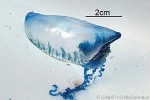Cook Islands Biodiversity Database
Species Page
Physalia utriculus
Tū-pakipaki-taiBluebottle
Multimedia & Additional Resources
| Type | Description | Download |
| Adult (Rarotonga) | 70KB | |
| Adult (Northland, NZ) | 75KB |
General Information
Cook Islands Distribution
| Southern Group: Present Makatea: | ||||||||
RR |
MG |
AT |
MK |
MT |
AK |
PL |
TK |
MN |
++ |
P |
P |
||||||
| Northern Group: | |||||
TN |
MH |
RK |
PK |
NS |
SW |
Scientific Taxonomy
Physalia utriculus (La Martinière, 1787)
SYNONYMS: Physalia physalia [mistakenly]
TAXONOMY: ANIMALIA; CNIDARIA (=Coelenterates); HYDROZOA; Siphonophora; PHYSALIIDAE
More Information
SIGNIFICANCE NOTES -
NEGATIVE SIGNIFICANCE: Poisonous sting - very serious. Comments: NBSAP - Takitumu (9 of 9 animal pests)
GENERAL NOTE: The "fishing line" has powerful stinging cells which can inflict a very painful sting, and stinging cells can continue to discharge for a long time. TREATMENT: immediately lift off "fishing-line" with clothing, and apply vinegar (3% acetic acid). Removing the thread stops further injections of poison, and the vinegar inhibits stinging-cell activity. DO NOT use methylated spirits, alcohol, human urine or freshwater as these increase the activity of stinging-cells, and vinegar (apparently) increases nematocyst discharge for Physalia physalia. After the initial treatment the injured skin can be treated with ointments, antihistamines or even meat tenderizer (papain). The toxins are proteins, which act on the nervous system. In severe cases, where headaches, nausea, collapse etc occur, seek immediate medical assistance. Deaths have not been substantiated, although the extreme pain, or an extreme reaction to the toxin, may lead to drowning.
Vouchers & References
Vouchers:
Rarotonga: fieldspecimen+photo, Muri beach, 12/2004, Jill Crosby, with ID as Physalia utriculus by G.McCormack.
References:
None recorded.
Data Update History (information):
zTX, zB02, zM05a, zD02
Web Resources
Citation Information
McCormack, Gerald (2007) Cook Islands Biodiversity Database, Version 2007.2. Cook Islands Natural Heritage Trust, Rarotonga. Online at http://cookislands.bishopmuseum.org. ![]()
Please refer to our use policy.

